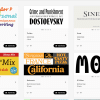Most business stakeholders know it’s important to speak clearly to their intended audience with their marketing. But it isn’t always easy to know what to say and how to say it. Does your brand have a voice?
So how do you go about creating a voice for your business that perfectly connects with your audience and infuses your greatest differentiators into your brand message?
Step 1: Start with a Mission Statement
If your business doesn’t have one, then get to work on this ASAP. Every business should have a mission statement. I can’t stress this enough. If your company is well-established, you likely have at least a few key stakeholders that should be involved in the making of a mission statement. If you already have one, read it. Meditate on it. Sit with it for a while. Write down any thoughts that come to mind.
Step 2: Create or Review Your Vision statement
Not only does you need to know what your business’ mission is but you also need to know where it is going (or where you would like it to go). This will help inform your marketing message but it will also be useful in making sure that employees (both present and future) and upper management are all on the same page with respect to the future of the of the business.
Step 3: Develop a Set of Core Values
Most clients and customers want to work with businesses that align with their values; and those that DO align with your values, will always be your best customers. So take the time, whether on your own or by forming a committee, to really drill down on what is most important to your business. Ask hard questions like how will what you do make lives easier or make the World a better place? What shared passions within your organization will galvanize your team?
Step 4: Come Up with a Strong Tag Line
Taglines are one of the most undervalued brand assets in small business marketing. A great tag line is the “golden egg” of your marketing toolkit. So don’t put it on the back burner but also, don’t rush through it. Now that you’ve done lots of thinking and brainstorming about who your business is, where it’s going and what makes it special, you have only to sit down and start riffing on short, sharp tag lines of no more than 6 words. If it’s longer than that, it isn’t a tag line – it’s a headline (see step 5). We like to make a Google Doc and share it with our team members allowing them to collaborate and brainstorm together.
Step 5: Write your headline
Imagine users are coming to your website and seeing your “hero area” for the first time. What sort of rallying cry or words of wisdom should greet them? A great headline is one that is incisive and powerful. We don’t follow any hard and fast rules of word limit for headlines. It’s most important it functions as it should and that is to grab your audience by their ears and deliver the sum total of your mission, vision and core values in as few words as possible. Easy-peezy-lemon-squeezy, right? It can be if you’ve followed steps 1-4.
Step 6: The “Elevator Pitch”
One of our most beloved clients told us during our first conversation that she didn’t believe in elevator pitches. But attention spans are shorter than ever. If you only had 30 seconds to tell a potential client about your business, what would you say? While it may not have felt right for this particular client, we strongly believe that most businesses can only benefit from having a well-crafted introduction to their business identity at the ready. We recommend creating three versions: a 30, 60-and 90-second version. The 30-second version should be about 75 words; the 60-second, 150 and the 90-second, 225. The EP, or Elevator Pitch, should kick off with a strong first line. Perhaps it’s a hard-hitting question that may keep your audience up at night. Or maybe it’s a startling fact that may strike a nerve. From there, jump right into telling your audience how you address that first statement. What makes your business different? Work on rolling out your story, mission and/or value proposition as clearly as possible. Since every word should count, taking the time to fuss over each word will time well-spent.
Developing a voice for a business brand boils down to developing thoughtful messaging that perfectly communicates the who, what and why of your business to exactly the right audience. It isn’t easy or fast (it can be fun though). However, business stakeholders that put the time and effort into creating a voice for their business, will find that all of their marketing efforts will be easier, more effective and most of all, reach those ears, eyes and hearts that matter most.















